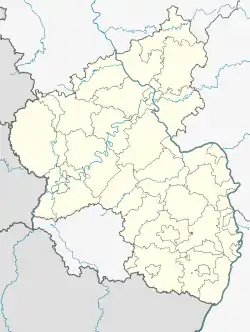Reich, Germany
Reich is an Ortsgemeinde – a municipality belonging to a Verbandsgemeinde, a kind of collective municipality – in the Rhein-Hunsrück-Kreis (district) in Rhineland-Palatinate, Germany. It belongs to the Verbandsgemeinde Simmern-Rheinböllen, whose seat is in Simmern.
Reich | |
|---|---|
Location of Reich within Rhein-Hunsrück-Kreis district  | |
 Reich  Reich | |
| Coordinates: 50°0′17″N 7°25′58″E | |
| Country | Germany |
| State | Rhineland-Palatinate |
| District | Rhein-Hunsrück-Kreis |
| Municipal assoc. | Simmern-Rheinböllen |
| Government | |
| • Mayor | Reiner Bonn |
| Area | |
| • Total | 4.76 km2 (1.84 sq mi) |
| Elevation | 410 m (1,350 ft) |
| Population (2019-12-31)[1] | |
| • Total | 338 |
| • Density | 71/km2 (180/sq mi) |
| Time zone | UTC+01:00 (CET) |
| • Summer (DST) | UTC+02:00 (CEST) |
| Postal codes | 55471 |
| Dialling codes | 06761 |
| Vehicle registration | SIM |
Geography
History
In the mid 16th century, Reich had its first documentary mention in a Weistum from the Ravengiersburg Monastery (a Weistum – cognate with English wisdom – was a legal pronouncement issued by men learned in law in the Middle Ages and early modern times). With the monastery's dissolution and the introduction of the Reformation, the village passed to the Duchy of Palatinate-Simmern, and then in 1673 to Electoral Palatinate. Beginning in 1794, Reich lay under French rule. In 1814 it was assigned to the Kingdom of Prussia at the Congress of Vienna. Since 1946, it has been part of the then newly founded state of Rhineland-Palatinate.
Politics
Municipal council
The council is made up of 8 council members, who were elected by majority vote at the municipal election held on 7 June 2009, and the honorary mayor as chairman.[2]
Mayor
Reich's mayor is Reiner Bonn.[3]
Culture and sightseeing
Buildings
The following are listed buildings or sites in Rhineland-Palatinate’s Directory of Cultural Monuments:[5]
- Auf dem Wasem – memorial site for the victims of the First and Second World Wars; small complex with oaktrees, memorial stone and crosses
- Hauptstraße 20 – former school between Reich and Wüschheim; timber-frame building, partly slated, about 1910
Sport and leisure
Running through the village is the newly built Biebertaler Rundweg (path).
References
- "Bevölkerungsstand 2019, Kreise, Gemeinden, Verbandsgemeinden". Statistisches Landesamt Rheinland-Pfalz (in German). 2020.
- Municipal election results for Reich
- Reich’s mayor
- Image of Reich’s arms
- Directory of Cultural Monuments in Rhein-Hunsrück district
External links
| Wikimedia Commons has media related to Reich (Hunsrück). |
- Reich in the collective municipality’s webpages (in German)
